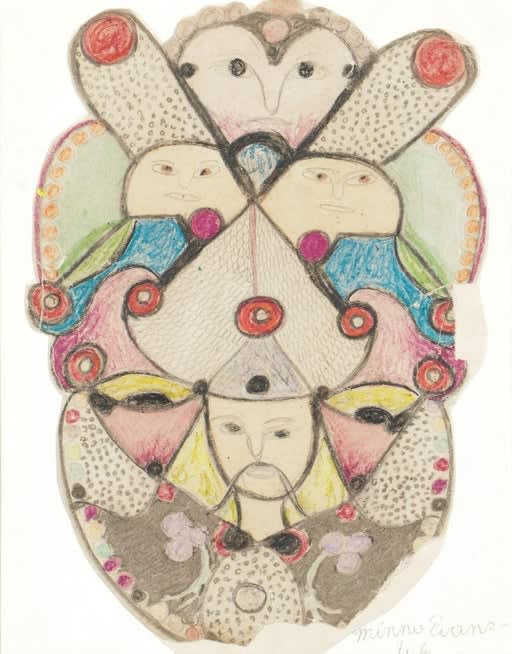Minnie Evans American, 1892-1987
The work of Minnie Evans depicts visions and dreams of an intimate, deeply spiritual world that expands like a kaleidoscope. Evans’s ancestors were slaves brought to the United States from Trinidad, and her mother was only thirteen years old when Minnie was born in a log cabin in Long Creek, Pender County, North Carolina. She attended school through the sixth grade, dropping out to sell oysters and clams. In 1908 Evans moved with her family to Wrightsville Beach, in New Hanover County, North Carolina, where she remained for most of her life. Employed as a domestic worker, she married, had three sons, and in the mid 1930s discovered art. In 1948 she took a job as a gatekeeper at Airline Gardens in the Pembroke estate, a post that she held for more than twenty-five years, her most prolific as an artist. Evans routinely created hundreds of drawings and sold them to visitors for a few dollars, but in 1961 she had her first exhibition at the Little Gallery in Wilmington, and soon met the photographer Nina Howell Starr, who became her main patron and promoter.
Evans began working with crayons and later incorporated graphite, ink, wax, oils, and collage into her work, a fusion of a rich visual imagination, biblical tradition, and island folklore. She claimed to have had visions since early childhood, and her religious faith inspired most of her creations. The persistent symbolism in Evans’s paintings was something she herself could not explain; working intuitively, she produced lush, sprawling, dense compositions with a sense of rhythm and symmetry. Brightly colored sinuous botanical motifs and patterns enclose the faces of deities, animals, mythological creatures, and a winged God. Flowers, leaves, and butterflies intertwine with calm open eyes, smiling lips, and blooming halos. “The paintings and colored drawings of Minnie Evans are surrealistic without intellectualism or self--consciousness,” as the art historian Regenia A. Perry has described them. “They are the works of a visionary who equated God with nature, color with His divine presence, and dreams and visions with reality . . . -[H]er paintings shimmer with the complexity of Byzantine mosaics. And like Byzantine mosaics, Evans’ works embody a common religious intent and express the -omnipotence of God.”
Evans retired from her job at Airline Gardens in 1974 and moved to an assisted living facility in 1981, where she continued to draw and paint until her death at age ninety-five. Evans’s work is in the collections of the Cameron Art Museum (Wilmington, North Carolina), the Smithsonian American Art Museum (Washington, D.C.), the Museum of Modern Art (New York), the Whitney Museum of American Art (New York), the American Folk Art Museum (New York), and the Newark Museum (New Jersey).


